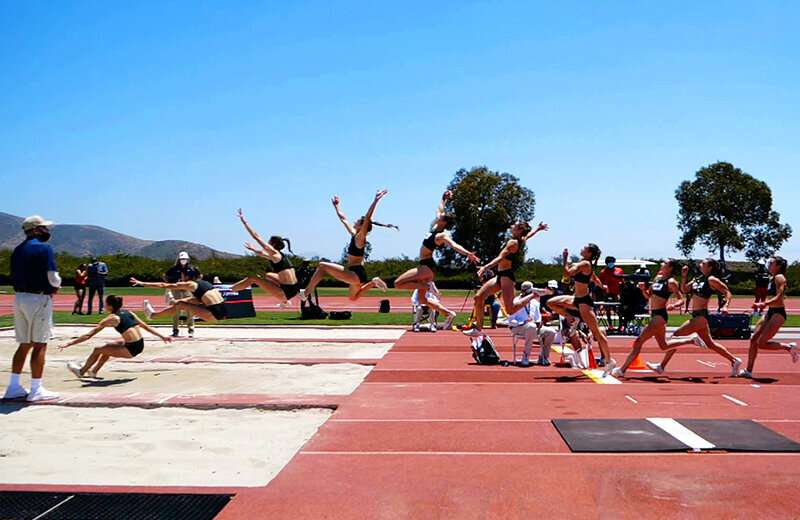By mapping athletes body movements, researcher puts Olympians on track to win


The young woman accelerates rapidly, launching into a short sprint that takes her down the runway to the takeoff board, where she uses one foot to launch herself upward. Keeping control over her body during flight, she lands feet-first into the sand pit and pitches forward.
Now it’s time for technology to take over.
Reviewing the strobe-motion video of the jump, the data gleaned from the athlete’s body motion and readings from the force plates below the runway, Jill McNitt-Gray, professor of biological sciences and biomedical engineering at the USC Dornsife College of Letters, Arts and Sciences, charts out the jumper’s velocity and jump angle, the load placed on the takeoff leg and other variables in order to identify the strongest and weakest parts of her performance.
“There’s more than one way to get the job done, so you’re really targeting people’s individual strengths and maximizing them. And if you can identify limitations, then you can work with the coaches, physical therapists, physiologists and others to improve through targeted training,” says McNitt-Gray, who holds a joint appointment at the USC Viterbi School of Engineering.
Through detailed, individualized data, coaches and researchers can see whether an athlete is having trouble controlling speed in the leadup run, controlling the leg on the takeoff board or consistently accelerating the body at the beginning of the jump. They can also troubleshoot motions that might place the athlete at risk for injury, such as placing too much weight on one leg or ankle during the landing.
“There may be areas for improvement that are very different from one athlete to another, so it’s not a one-size-fits-all scenario. More than one solution will get you there, and that’s why a lot of the research that we do is related to how an individual improves their performance,” she explains.
Three decades of Olympic efforts
The jump was one of many performed during the recent U.S. Track & Field (USATF) team trials for the Olympic Games in Tokyo. For the past three quadrennials—since before the 2012 Summer Olympics in London—McNitt-Gray has been working with USATF athletes in the “horizontal jumps”: the long jump and the triple jump. The latter is an event similar to the long jump in which a person must complete three jumps, starting by running off one foot (hop), switching to the opposite one (step), and then taking off of the same foot that was used for hop (jump).
McNitt-Gray has worked with Olympians and Paralympians in various events, including diving, volleyball, basketball and different Paralympic sports, for 35 years. Her interest in athletics and movement stretches back to her college days when she was a competitive gymnast and field hockey player.
“I think as a gymnast you end up being like a practicing physicist in order to figure out how you fly through the air and land without getting hurt,” she says.
https://youtube.com/watch?v=8y3tjMrDMDA%3Fcolor%3Dwhite
After college, McNitt-Gray used her degrees in math and statistics to continue studying mechanics, getting a job at an electrical utility company where she looked at load distribution. Her first project of her doctoral program was to analyze high-speed film taken during the 1984 Olympic Games in Los Angeles. After earning her Ph.D. in biomechanics, she came to USC Dornsife to pursue her research and continue her work with athletes training for the Olympic and Paralympic Games.
Much has changed since McNitt-Gray began her career. Initially, scientists and trainers used film cameras to capture movement, but it took several days to develop the film and give feedback. Stopwatches measured time, though not quite to the degree today’s instruments can. Researchers also made their own equipment for electromyography to monitor muscle recruitment and activation.
Today, however, athletes have smart watches and other wearable monitoring devices to record some of their biometrics. And high-speed video cameras give a greater opportunity to catch detailed movements.
“I think now with more portable technology, better data management skills, more algorithmic developments, we’re able to get a much clearer picture of patterns that may be evolving. And especially those that are linked to putting an athlete at risk, or those that help them control their body in ways that improve performance,” she says.
An athlete weighs in
Madisen Richards, a long jumper who graduated from USC Dornsife in 2018 with a degree in human biology, was on the USC Track & Field team during her time as a student. She says she learned much from McNitt-Gray both as a teacher and as an athlete.
“Using data from force plates that were then analyzed by the USC biomechanics team allowed me to discover just how much further I could jump by either improving my horizontal or vertical velocity at takeoff,” she says. “I learned that it’s more beneficial for me to have more horizontal velocity at takeoff, so this season I worked on speed development a lot in order to help improve that.”
Richards, who was part of the USC team that won the NCAA Division 1 Championship in 2018 and who was also USC’s first women’s outdoor long jump All-American since 1999, participated in her first U.S. Olympic track and field trials this summer.
McNitt-Gray says that her research is not solely aimed at athletes. Body movement and force are also important for astronauts, who need to control their bodies in space, and people with disabilities. Prosthetic use, for example, can vary greatly depending on whether it is fitted above the knee or below it, so understanding those forces can help people prevent injury.
For the next few weeks, however, McNitt-Gray’s eyes will be on Tokyo, as she watches to see how her track and field athletes—and Team U.S. as a whole—will do in the Games.
Source: Read Full Article




